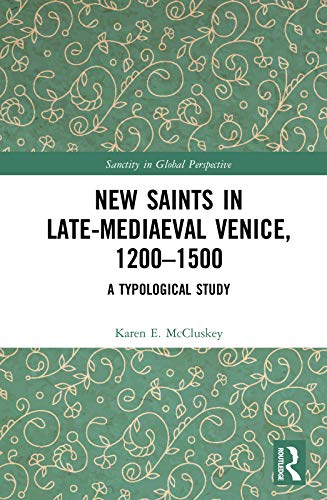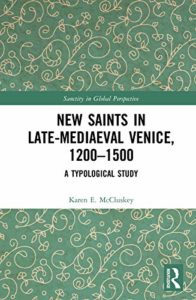
New Saints in Late-Mediaeval Venice, 1200-1500: A Typological Study by Karen E. McCluskey

Late medieval Italian cities were fertile ground for the flourishing of lay sanctity. Karen McCluskey’s New Saints in Late-Mediaeval Venice investigates the lives, cults, and typologies of the santi novellini—new civic saints—who were holy people exalted by their compatriots and venerated at votive sites. The book argues that Venetian foundational myths played an important role in forming and informing new civic cults. In a city with a centenary mythical history, four different Venetian communities, the Republican government, Benedictine and Mendicant monastic orders, and local parishes operated a Venetianization of standard typologies of sainthood that produced a unique local devotional tradition, a sanctity alla veneziana.
Partly inspired by innovative studies by French scholar André Vauchez on saints’ cults and popular piety in late medieval Europe, McCluskey offers an original intervention on saintly typologies and their cultic expressions in Venice. Shifting away from broad geographical and chronological spans, the author narrows her focus to investigate how Venetian communities perceived, remembered, and interacted with their saints in their daily lives. To reconstruct the lived and multilayered relationships between devotees and their saints, the author analyzes a multitude of visual and textual sources, including hagiographic portraits painted in vita panels, written vitae, votive images, relics, sermons, sepulcher monuments, and as archival records. By doing so, the author offers a clear picture of the Venetian social groups that created new saints and endorsed them.
Civic saints functioned at multiple levels, in governmental as well as in local and more intimate settings that shaped saints’ purposes and qualities. The Venetian Republic had mostly political interests in endorsing new saints. The government wanted to bolster the ideology that Venice was predestined as a locus sanctus sanctioned by God. Officials also sought to create meaningful links between the city’s civic piety and its foundational myth. According to Venice’s myth, God protected the city from the Lombards and Huns, foretold the birth of Venice to Mark the Evangelist, and ordained the Venetians’ translation of that saint’s relics from Alexandria to the lagoon. The cults of new saints offered the government an opportunity to cast them as agents of the city’s destiny. Venetians used hagiographies—written and visual—as media to establish a typology of Venetian sanctity within the overall context of the city’s myth. The extensive mosaic found in the Baptistery of Saint Mark’s basilica portraying the doge-monk Pietro Orseolo is filled with dogal allusions that add a civic dimension to the salvation narrative and show how the office of the doge was imbued with divine favor. The funerary arca commissioned by the city for Venetian Dominican monk Giacomo Salomoni in Forlì advertised the glory of Venice and its perfect Christianity. Giacomo’s deeds and holy virtue projected an image of the city as a holy republic and reinforced the myth of Venice as God’s preferred place. The vitae of Saint Lorenzo Giustiniano, Venice’s first patriarch, portrayed Lorenzo as a product of the holy city. His diplomatic engagement in amplifying the role of the Venetian church in Europe and his charitable activities toward his compatriots made him the perfect model of Venetian virtue characterized by a deep civic consciousness. Local elites endorsed a typology of the civic saint that enhanced the greater good of the state.
Monastic groups also promoted their own pantheons. Following contemporary religious trends present on the Italian peninsula, Benedictine and Mendicant orders constructed their saints as pious friends of Christ and as spiritual guides for their brothers and sisters. Contrary to other Italian communes where Mendicant saints were thriving, Venetian Benedictine monasteries managed to create an interactive spirituality with the city’s citizens despite their claustration. The written and visual portrayals of the Benedictine saints, of Giuliana of Collalto, abbess at the monastery of Santi Biagio e Cataldo, of Leone Bembo, bishop at San Lorenzo, and of Giovanni Plebiano, a parish priest at San Zan Degolà, were intimately connected to the Benedictine environment but also tied to local historical circumstances. The saints had miraculous intercessory powers that associated them with Venetian contemporary challenges like social inequality, disease, child mortality, and injustice. To establish meaningful connections with the people who endorsed them, the saints’ hagiographers inserted into the saints’ vitae recognizable social types, contemporary anecdotes, and broad social anxieties. For example, in her painted casket and vita panels, Giuliana miraculously cured a lay sister, whose arm had been injured, and freed a youth from prison and death. These episodes highlighted her healing and intermediary powers between heaven and earth. Leone and Giovanni’s vitae focused on child-healing. Leone restored the vision of a noble Venetian man’s daughter, restored the voice of a young girl, and saved an infant from death. Thanks to his thaumaturgic powers, Giovanni performed salvific acts on young nuns, women, and wives in Venice. These acts evoked Venetians’ fears about the precariousness of life, especially regarding children’s mortality. Indeed, children guaranteed the city’s future, and noble families depended on children’s survival to guarantee the survival of their lineage. Therefore, Benedictine saints offered solace to tangible social anxieties.
Mendicant saints maintained an unusual distance from their devotees despite the mushrooming of their religious foundations. The political tensions between the religious orders and the Venetian government affected the development of major saints’ cults as testified in the lack of clear evidence of cultic devotional and visual culture. Not even the cult of fourteenth-century Dominican tertiary Maria Sturion, whose life was recorded by the famous hagiographer Tommaso Caffarini, the confessor of Saint Catherine of Siena, has survived, due to her humble and modest life that did not enhance or confirm Venice’s pious civic identity. Additionally, Maria’s vita, written by the foreigner Caffarini, did not include that venezianità, which was necessary for a cult to thrive.
New cults in Venetian parishes flourished in this period. Parish saints were active members of local communities and highly involved in their neighborhoods’ spiritual and physical well-being. Cast as protectors of the parish, these holy figures and their cultic expressions revealed the lived experiences of Venetians. The discomfort of severe winters and the dangers connected to water, poverty, hunger, and sickness shaped parish saints’ characteristics to mirror the character of cooperation, support, and succor around which small parish communities were built. Angelo Semitecolo, a parish priest at San Pantalon, developed a holy reputation as a man caring for the poor and lepers. The parish of San Basilio venerated the local saint Pietro Acotanto as a protector from the acqua alta, the high tide, and from winter sea storms. According to a sermon composed in his memory, the saint performed most of his charitable acts during these dreadful events, which affected the poor, the homeless, and Venetian infrastructures more broadly. The devout ascetic Contissa Tagliapietra, a patrician from the parish of San Vio, had the apotropaic power of saving children from falling into and drowning in Venice’s waters. Written and visual sources on parish saints reveal a great deal about the relationships of Venetian citizens to their saintly protectors. Absent a centralized welfare system, parishes and local charitable organizations played a key role in providing the necessary support to those in need and in maintaining peace within their neighborhoods.
Furthermore, the lives of Giuliana, Maria, and Contissa illuminate the important gendered dimension of female sainthood in Venice. Women saints were portrayed as “imitable saints” for their devotees and were deeply woven into the local social fabric. Under the auspices of monastic orders, these women gained notoriety and established new ways of responding to the needs of Venice. They tended to the poor, healed the sick, sheltered the homeless, and cared for prisoners. The lived experiences of these women offer an important counterpoint to traditional interpretations of women’s role in Italian society. These lives testify to the existence of spaces for women’s participation in the spiritual life of late medieval and Renaissance Italian cities, highlighting the active, creative role that many women played in the religious life of this period. In the religious sphere, late medieval Venetian women were often able to emerge as active shapers of civic culture.
Previous scholarship has established that late medieval and Renaissance Venice was in conversation with Italian and European religious and cultural trends, yet maintained its own particularism. The typologies of sainthood most common in Venice, such as charity, piety, humility, and asceticism, aligned with European ones. However, as McCluskey has so aptly shown, Venice stood out among late medieval urban societies in which the majority of new cults remained localized and few were ever celebrated officially. Venice’s discomfort with onomastic cults speaks to the city’s need to suppress personal glorification to favor the collective virtue of the Republic. To a greater and lesser degree, new Venetian saints had the wider purpose of serving the city and its destiny. The complex interplay of myth, state, society and environment shaped local saints and their actions to enhance the city’s reputation as God’s favored locus sanctus.
Giulia Giamboni is a PhD candidate in medieval history at the University of California, Santa Barbara. Her research engages with women’s charitable activities in the cross-cultural colonial context of late medieval Dalmatia (Croatia).
New Saints in Late Medieval Venice 1200-1500. A Typological Study
By Karen E. McCluskey
Publisher: Routledge
Hardcover / 268 pages / 2020
ISBN: 9781138478008
Published on January 3, 2023




